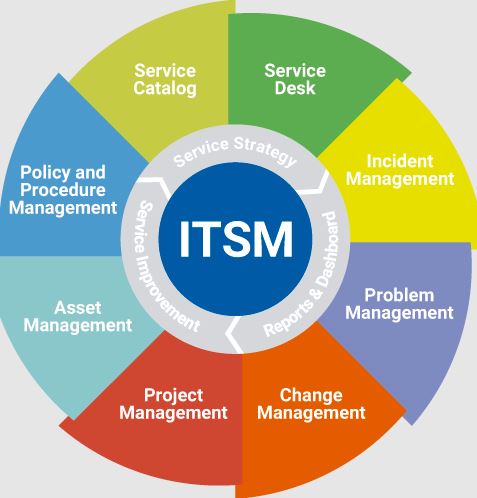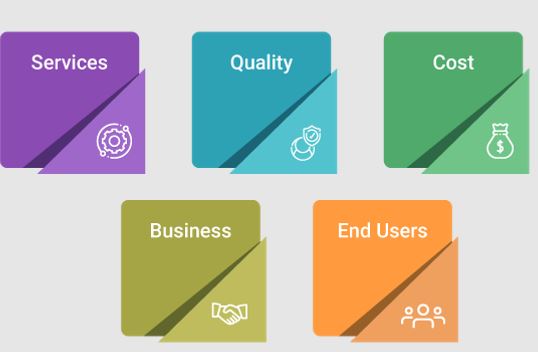- ITIL Tutorial – Incident & amp Problem Management | The BEST Step-By-Step Guide
- ITIL4 Service Value Chain Model Tutorial | Everything You Need to Know
- The ITIL 4 Service Value System | The BEST Step-By-Step Guide
- What are the ITIL 4 Management Practices? | Tutorial for Learning Path
- Guiding Principles of ITIL 4 | Learn Now Tutorial
- Four Dimensions of Service Management in ITIL 4 | A Definitive Guide
- What is the Continual Improvement Model? ITIL Tutorial
- ITIL4 Tutorial | A Complete Guide for Beginners
- Continual Service Improvement (CSI)Tutorial | Learn the Methods and Techniques
- Service Transition Overview – ITIL Tutorial
- ITIL® 4 Foundation Tutorial | The Ultimate Guide
- Design an Effective IT Service with ITIL® v3 Tutorial
- Nagios Tutorial
- ITIL – Service management lifecycle Tutorial
- Service Validation and Testing Tutorial
- Service Operation Processes Tutorial
- ITIL Turtorial
- Services Strategy Tutorial
- ITIL Intermediate SOA – Demand Management Tutorial
- Availability Management Tutorial
- ITIL Key Concepts of the Service Lifecycle Tutorial
- ITIL Change Evaluation Tutorial
- The principles of COBIT® 5 Tutorial
- ITIL Intermediate CSI – Continual Service Improvement Processes Tutorial
- ITIL-Service Level Management Tutorial
- ServiceNow Tutorial
- SCCM Tutorial
- ITIL Tutorial – Incident & amp Problem Management | The BEST Step-By-Step Guide
- ITIL4 Service Value Chain Model Tutorial | Everything You Need to Know
- The ITIL 4 Service Value System | The BEST Step-By-Step Guide
- What are the ITIL 4 Management Practices? | Tutorial for Learning Path
- Guiding Principles of ITIL 4 | Learn Now Tutorial
- Four Dimensions of Service Management in ITIL 4 | A Definitive Guide
- What is the Continual Improvement Model? ITIL Tutorial
- ITIL4 Tutorial | A Complete Guide for Beginners
- Continual Service Improvement (CSI)Tutorial | Learn the Methods and Techniques
- Service Transition Overview – ITIL Tutorial
- ITIL® 4 Foundation Tutorial | The Ultimate Guide
- Design an Effective IT Service with ITIL® v3 Tutorial
- Nagios Tutorial
- ITIL – Service management lifecycle Tutorial
- Service Validation and Testing Tutorial
- Service Operation Processes Tutorial
- ITIL Turtorial
- Services Strategy Tutorial
- ITIL Intermediate SOA – Demand Management Tutorial
- Availability Management Tutorial
- ITIL Key Concepts of the Service Lifecycle Tutorial
- ITIL Change Evaluation Tutorial
- The principles of COBIT® 5 Tutorial
- ITIL Intermediate CSI – Continual Service Improvement Processes Tutorial
- ITIL-Service Level Management Tutorial
- ServiceNow Tutorial
- SCCM Tutorial

Four Dimensions of Service Management in ITIL 4 | A Definitive Guide
Last updated on 18th Aug 2022, Blog, IT service and Architecture, Tutorials
Introduction
Stakeholders exist in any part of a company’s business and in any reasonably organization. They additionally exist in our lifestyle. So, during this article, I’ll clarify WHO the stakeholders square measure, the way to approach them, and why (and how) they’re employed in ITSM organization.
Who square measure the stakeholders?
According to the ITIL definition, a neutral is “a one who has associate interest in a corporation, project, IT service etc.” Let Pine Tree State justify with a non-IT example. take into account an organization – WHO would be stakeholders in it? staff, managers, board of management, shareholders, syndicates, customers, suppliers, vendors… etc. But, also, e.g., the community wherever this organization will business. that has universities that have an interest in ensuring that their students have an area to figure once they’re finished university. everybody living within the town wherever the corporate is found may even be stakeholders. for instance, if the corporate has production facilities, everybody within the town is inquisitive about whether or not the assembly considers the best environmental standards (e.g., ISO 14001). So, those would be stakeholders during a company.
How concerning IT services and ITSM?
IT services (and, consequently, ITSM) cope with stakeholders in virtually each method and throughout the ITSM organization. Stakeholders of associate IT service square measure staff of the ITSM organization and also the organization’s management, alternative staff of the corporate, management of the corporate, users and customers, vendors, suppliers, regulators, partners, etc. all of them have interest in IT services.
Stakeholders may be divided into 2 categories:
Internal:These square measure groups, groups, and staff WHO add constant organization. just in case of internal IT suppliers, this additionally suggests that internal customers.
External:These square measure all parties WHO aren’t a part of constant organization: usually, external customers or suppliers.

Why are they important?
Simply put, they’re necessary as a result of stakeholders of the IT services and ITSM organization embody everybody you wish to deliver the services (e.g., users) or to be supported (e.g., customers). So, you can’t live while not them. But, let Pine Tree State elaborate on this in additional details. It’s necessary to know WHO the stakeholders of the IT services square measure, however they’re exploitation the services, and what their interests square measure. If you recall the IT service lifecycle – that’s set within the scope of Service Strategy (read the article ITIL Service Strategy: What and Why of ITSM to find out more). By being clear on WHO the stakeholders of your IT services square measure, you’re ready to outline supporting organization (roles, responsibilities, teams… etc.), processes, the way to manage interfaces between processes and totally different roles, etc. So,in totally different stages of the IT service lifecycle you’ll need to take into account different aspects of the neutral necessities (e.g., by understanding your stakeholders’ demand towards the service(s), you’ll be ready to respond with applicable capacity).
Let’s see a couple of examples wherever stakeholders’ involvement is important:
Defining the service:Service Portfolio Management should watch out that stakeholders square measure concerned within the definition and analysis of the service. I had witnessed a project wherever the service was outlined and enforced by IT while not the involvement of business and selling (i.e., the proper stakeholders) and it ne’er succeeded. scan the article ITIL Service Portfolio Management method summary to find out additional.
Deploying the service:Stakeholders ought to learn concerning the progress of the service implementation throughout the project. In such manner, stakeholders can feel concerned in putting in place the service, however additionally it’ll be a lot of easier to involve them in any necessary steps like, e.g., testing. If stakeholders involve external parties just like the customers of a provider, then Service Level Manager/Business Relationship Manager and provider Manager are going to be concerned.
Service operation and observance:– operation activities directly have an effect on stakeholders’ (in this case – users’ and customers’) satisfaction. Therefore, it’s necessary to know stakeholders’ interests and the way they use the services so as to optimize outputs (services delivered). observance provides direct info to the Service Level Management, ITSM, and client (all square measure stakeholders of a specific service) concerning the standard of the provided service and support groups.
And ISO 20000?
ISO 20000 doesn’t use the word neutral, however – interested party. By definition, associate interested party may be a “person or cluster having a particular interest within the performance or success of the service provider’s activity or activities.” From the importance and involvement within the Service Management System (SMS) processes and connected activities, interested party corresponds to neutral. So, everything mentioned on top of (i.e., ITIL related) is valid for ISO 20000. scan the article five key advantages of ISO 20000 implementation concerning ISO 20000 implementation.
Two-way road
As you may see, stakeholders have an interest within the activities, targets, resources, or deliverables. Their involvement isn’t unidirectional, however rather bifacial. The ITSM organization has clear interests to surpass throughout the IT service lifecycle. perhaps indirectly, however that’s additionally the customer’s interest as a result of they have services to be delivered at the best quality. That’s why stakeholders, their interests, and their involvement square measure very necessary.
Therefore, analyze WHO the stakeholders of your services square measure, communicate with them, and allow them to say what they suppose – within the service definition part likewise as (even additional important) once the service is within the live atmosphere.
- Enable the client to realize their goals
- Provide price for cash for the organization
Service management may be a set of specialized structure capabilities for facultative price for patrons within the style of services. These capabilities embody tangible things like capital, people, and instrumentality, and might additionally embody intangible things like data, management and skills. These capabilities also can embody intangible things, like data, management, and skills.
The goal of IT service management is to maximize the worth delivered and obtained from technology-driven merchandise and services. To succeed at service management, these ideas square measure crucial:
- Value co-creation
- Stakeholders in commission management
- Service relationships
- Products & service
- Value,Outcomes, prices & Risk
- Utility & warrantee
Value Co-Creation
The purpose of a company is to form worth for stakeholders. Here, worth is outlined as:
- Perceived advantages
- Usefulness
- Importance
Value is subject to the perception of the stakeholders, whether or not they be the shoppers or customers or the organization itself. place confidence in a ride sharing service: for a few folks the worth is convenience; for others it’d be price or flexibility. worth may be subjective, reckoning on the purpose of read.
In the past, organizations viewed themselves as ‘service providers’, delivering worth to their clients in a very mono-directional manner: the supplier delivering worth to the customer, whereas the client plays no role in worth creation. This model, however, has become noncurrent.
Organizations currently acknowledge that worth is co-created through a lively collaboration between suppliers and customers. This co-creation is increased by the work of alternative stakeholders that square measure a part of the relevant service relationships.
Stakeholders in commission Management
This new perspective important co-creation leads to a crucial ought to establish all the players United Nations agency square measure concerned. this might embrace suppliers, consumers, financiers, regulators—even influencers. Let’s establish a number of the most stakeholders in commission management:
The term service client is generic naturally, thus we will additional delineate roles such as:
Customer:An individual United Nations agency defines the wants for a service and takes responsibility for the outcomes of service consumption; e.g., the IT Manager.
User:An individual United Nations agency uses services; e.g. the corporate staff.
Sponsor:An individual United Nations agency authorizes take into account service consumption; e.g., the Finance Manager.
Note that these terms may be utilized by one individual United Nations agency will act because the client, user, and sponsor of a service they need bought and consumed.
Beyond the buyer and supplier roles, several alternative stakeholders square measure typically necessary to worth creation. characteristic these roles in commission relationships ensures effective communication and neutral management.

Service Relationships
A service relationship is outlined because the cooperation between a service supplier and repair client. Service relationships square measure established between 2 or a lot of organizations to co-create worth. a company will play the role of supplier or client interchangeably, reckoning on things.
Service relationships include:
- Service provision
- Service consumption
Service relationship management, that square measure the joint activities performed by a service supplier and a service client to make sure continual worth co-creation supported in agreement and on the market service offerings.
The service relationship model is employed to showcase the changing interaction between service suppliers and customers. a company will procure services and use them to deliver services to a different client, so shifting from client to supplier. for instance, a center might purchase web services from a provider then use those services to produce client relationship management services for its customers.
Products & Services
In ITIL, the service is that the final center of focus in each facet of service management. A service is outlined as a way of enabling worth co-creation by facilitating outcomes that customers need to attain, while not the client having to manage specific prices and risks. The services that a company provides square measure supported one or a lot of its merchandise.
A product is any configuration of an organization’s resources designed to supply worth for a client. Resources will embrace folks, capital, equipment, software, etc.
Service suppliers sometimes gift their services to customers within the variety of service offerings, that describe one or a lot of services supported one or a lot of merchandise. A service giving may be a description of 1 or a lot of services that square measure designed to handle the requirements of a target client cluster.
The 3 main elements of service offerings are:
- Goods
- Access to resources
- Service actions
Different offerings may be organized for various target client segments relying on:
- Demand
- Capacity to pay
- Additional factors/span>
Value: Outcomes, prices & Risks (VOCR)
Service suppliers facilitate their customers to attain outcomes and, in doing thus, wrestle a number of the associated risks and prices. However, the service relationship may end up in negative outcomes or introduce new or antecedently unknown risks and prices.
Service relationships square measure perceived as valuable only if they need a lot of positive effects than negative, significantly relating to impact on outcomes, costs, and risks.
Outcomes
When a company acts as a service supplier, it produces outputs that facilitate its customers to attain sure outcomes. AN output is outlined as a tangible or intangible deliverable of AN activity; for instance, transportation from one location to a different.
An outcome, in contrast, is that the result for a neutral that was enabled by one or a lot of outputs. If the output is transportation between locations, the result can be that the neutral has AN interview or doctor’s appointment.
Depending on the connection between the supplier and also the client, it may be tough for the supplier to totally perceive the outcomes that the buyer desires to attain. In some cases, each parties can work along to outline the required outcomes.
Costs
Costs square measure the quantity of cash spent on a selected activity or resource. From the service consumer’s perspective, there square measure 2 varieties of price concerned in commission relationships:
- Costs aloof from the buyer by the service (a part of the worth proposition). for instance, for automotive sharing service, the client doesn’t pay money for the particular price of buying the automotive.
- Costs obligatory on the buyer by the service (the prices of service consumption). in a very automotive sharing service, the client pays for cellular or web services to request the service.
- The two varieties of price should be totally understood if a service supplier is to get worth for cash and make sure the right choices square measure created regarding the service provision. suppliers ought to make sure that services square measure delivered at intervals budget constraints and meet the monetary expectations of the organization.
Risks
A risk is any event, together with potential events, that would cause hurt or loss or create it tougher to realize objectives. Risk is taken into account Associate in Nursing unsure outcome, one that that may be positive or negative. 2 varieties of risk square measure regarding to service consumers:
- Risks far from a client by the service (part of the worth proposition). for instance, for a web streaming service, the failure of kit concerned in delivering the service.
- Risks obligatory on a client by the service (risks of service consumption). For a web streaming service, the threat of legal proceeding for infringement of copyright.
It is the duty of the supplier to manage the elaborated level of risk on behalf of the patron. However, the patron features a role to play in causative to risk reduction as a perform important co-creation. the patron contributes to reducing risk by:
- Actively taking part in process the service necessities and elucidative its needed outcomes, usually on Associate in Nursing current basis.
- Clearly human activity the essential success factors (CSFs) and constraints that apply to the service.
- Ensuring the supplier has access to the mandatory client resources throughout the service relationship.
Utility & warranty
How will we recognize that a service is delivering price for the patron and meeting the service provider’s requirements? By evaluating, in totality, the utility and warrant of the service.
Utility is that the practicality offered by a product or service to fulfill a specific would like. Utility maybe answers ‘what the service does’ or whether or not a service is ‘fit for purpose’. to possess utility, a service should either support the performance of the patron and/or take away constraints from the patron.
Warranty, on the opposite hand, is that the assurance that a product or service can meet in agreement necessities. warrant answers ‘how the service performs’ or whether or not a service is ‘fit for use’. warrant usually relates to service levels aligned with the wants of service customers, like availableness, capacity, security, and continuity.
When assessing a service, you need to take into account the impact of prices and risks on utility and warranty—this generates a whole image of the viability of a service. each utility and warrant square measure essential for a service to facilitate its desired outcomes and, therefore, facilitate produce price. for instance, if you’re employing a traveler delivery service, the utility involves the delivery of your packages whereas warrant is concerning the speed and handling of your packages.